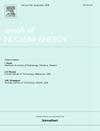Development and application of a neutronics/thermal-hydraulics coupling code based on system code and Anderson acceleration
IF 1.9
3区 工程技术
Q1 NUCLEAR SCIENCE & TECHNOLOGY
引用次数: 0
Abstract
In a main steam line break (MSLB) accident, the degree of mixing of coolant with different temperatures in the lower plenum can significantly affect the power distribution of core, which in turn impacts core safety. The point kinetics model used in traditional system codes is unable to simulate spatial variations in power. To investigate this phenomenon in greater detail, it is essential to couple the system code with a 3D neutron dynamics code. In the development of neutronics/thermal-hydraulics coupling codes based on system codes, operator splitting (OS) method and Picard iteration are often used to advance the time-stepping. The operator splitting method has lower accuracy, while the Picard iteration is an implicit coupling method to improve the computational accuracy of neutronic and thermal–hydraulic coupled codes. However, the convergence of Picard iteration is usually poor, the use of relaxation factors is required to ensure numerical stability. The selection of relaxation factors is typically a manual process, and the optimal range varies under different operating conditions. To enhance the convergence and efficiency of alternate calculations between the neutronic field and thermal–hydraulic field, Anderson acceleration was introduced into the coupled transient simulation of the system code NUSOL-SYS. The developed code with Anderson acceleration was used in transient numerical simulations, and the results demonstrated a significant reduction in the number of coupling iterations. For time steps involving rapid transient changes, the iteration count was reduced to approximately 76.5% of the original Picard iteration, while also eliminating the need for manual selection of relaxation factors. Further validation was performed using the NEACRP 3-D LWR core transient benchmark, where the computed results were in close agreement with reference solutions. Subsequently, the coupled code was applied to simulate the MSLB accident in a pressurized water reactor (PWR). The impact of coolant mixing in the lower plenum on transient parameters was investigated. The results revealed that increased coolant mixing led to lower return to power and reduced local power peaks.
基于系统代码和安德森加速的中子/热工耦合代码的开发与应用
在主汽断流事故中,不同温度的冷却剂在下充气室的混合程度会显著影响堆芯的功率分布,进而影响堆芯的安全。传统系统代码中使用的点动力学模型无法模拟功率的空间变化。为了更详细地研究这一现象,必须将系统代码与三维中子动力学代码耦合起来。在基于系统码的中子/热工-水工耦合码的开发中,通常采用算子分裂法和皮卡德迭代来推进时间步进。算子分裂法精度较低,而皮卡德迭代法是一种隐式耦合方法,可提高中子和热工耦合码的计算精度。然而,皮卡德迭代的收敛性通常较差,需要使用松弛因子来保证数值稳定性。松弛因子的选择通常是一个人工过程,在不同的操作条件下,最佳范围是不同的。为了提高中子场和热液场交替计算的收敛性和效率,在系统代码NUSOL-SYS的耦合瞬态仿真中引入了Anderson加速度。在瞬态数值模拟中使用了具有Anderson加速度的代码,结果表明耦合迭代次数显著减少。对于涉及快速瞬态变化的时间步长,迭代计数减少到原始Picard迭代的大约76.5%,同时也消除了手动选择松弛因子的需要。使用NEACRP 3-D LWR岩心瞬态基准进行进一步验证,计算结果与参考解决方案非常吻合。随后,将该耦合程序应用于某压水堆MSLB事故的模拟。研究了冷却剂在下腔内混合对瞬态参数的影响。结果表明,增加冷却剂混合导致较低的功率回报和降低局部功率峰值。
本文章由计算机程序翻译,如有差异,请以英文原文为准。
求助全文
约1分钟内获得全文
求助全文
来源期刊

Annals of Nuclear Energy
工程技术-核科学技术
CiteScore
4.30
自引率
21.10%
发文量
632
审稿时长
7.3 months
期刊介绍:
Annals of Nuclear Energy provides an international medium for the communication of original research, ideas and developments in all areas of the field of nuclear energy science and technology. Its scope embraces nuclear fuel reserves, fuel cycles and cost, materials, processing, system and component technology (fission only), design and optimization, direct conversion of nuclear energy sources, environmental control, reactor physics, heat transfer and fluid dynamics, structural analysis, fuel management, future developments, nuclear fuel and safety, nuclear aerosol, neutron physics, computer technology (both software and hardware), risk assessment, radioactive waste disposal and reactor thermal hydraulics. Papers submitted to Annals need to demonstrate a clear link to nuclear power generation/nuclear engineering. Papers which deal with pure nuclear physics, pure health physics, imaging, or attenuation and shielding properties of concretes and various geological materials are not within the scope of the journal. Also, papers that deal with policy or economics are not within the scope of the journal.
 求助内容:
求助内容: 应助结果提醒方式:
应助结果提醒方式:


